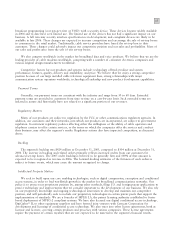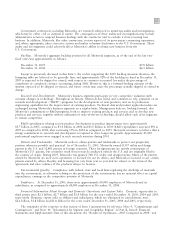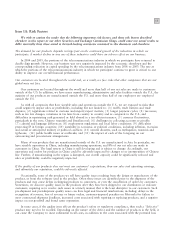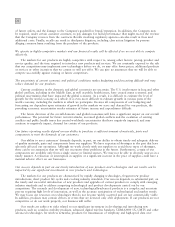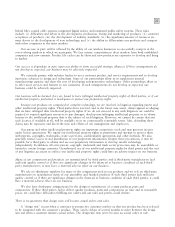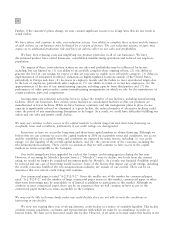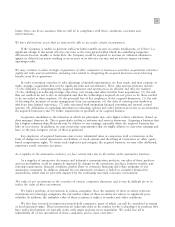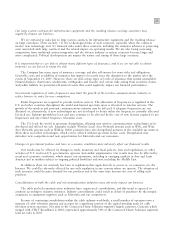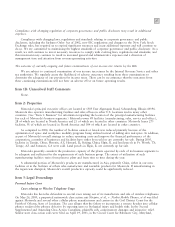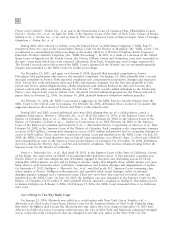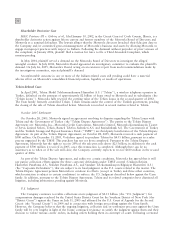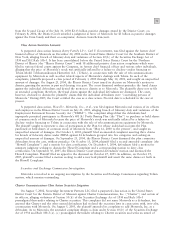Motorola 2005 Annual Report Download - page 32
Download and view the complete annual report
Please find page 32 of the 2005 Motorola annual report below. You can navigate through the pages in the report by either clicking on the pages listed below, or by using the keyword search tool below to find specific information within the annual report.
25
Our large system contracts for infrastructure equipment and the resulting reliance on large customers may
negatively impact our business.
We are exposed to risks due to large system contracts for infrastructure equipment and the resulting reliance
on large customers. These include: (1) the technological risks of such contracts, especially when the contracts
involve new technology, and (2) financial risks under these contracts, including the estimates inherent in projecting
costs associated with large contracts and the related impact on operating results. We are also facing increasing
competition from traditional system integrators and the defense industry as system contracts become larger and
more complicated. Political developments can impact the nature and timing of these large contracts.
It is important that we are able to obtain many different types of insurance, and if we are not able to obtain
insurance we are forced to retain the risk.
The Company has many types of insurance coverage and also self-insures for some risks and obligations.
Generally, costs and availability of insurance has improved recently since the disruption to the market after the
events of September 11, 2001. However, there are still certain types or levels of insurance that remain unavailable.
Natural disasters (hurricanes, windstorms, earthquakes and floods) and certain risks arising from securities claims
and public liability are potential self-insured events that could negatively impact our financial performance.
Government regulation of radio frequencies may limit the growth of the wireless communications industry or
reduce barriers to entry for new competitors.
Radio frequencies are required to provide wireless services. The allocation of frequencies is regulated in the
U.S. and other countries throughout the world and limited spectrum space is allocated to wireless services. The
growth of the wireless and personal communications industry may be affected if adequate frequencies are not
allocated or, alternatively, if new technologies are not developed to better utilize the frequencies currently allocated
for such use. Industry growth has been and may continue to be affected by the cost of new licenses required to use
frequencies and any related frequency relocation costs.
The U.S. leads the world in spectrum deregulation, allowing new wireless communications technologies to be
developed and offered for sale. Examples include Wireless Local Area Network systems such as WiFi, and Wide
Area Network systems such as WiMax. Other countries have also deregulated portions of the available spectrum to
allow these and other technologies, which can be offered without spectrum license costs. Deregulation may
introduce new competition and new opportunities for Motorola and our customers.
Changes in government policies and laws or economic conditions may adversely affect our financial results.
Our results may be affected by changes in trade, monetary and fiscal policies, laws and regulations, or other
activities of U.S. and non-U.S. governments, agencies and similar organizations. Our results may also be affected by
social and economic conditions, which impact our operations, including in emerging markets in Asia and Latin
America and in markets subject to ongoing political hostilities and war, including the Middle East.
In addition, there are currently few laws or regulations that apply directly to access to, or commerce on, the
Internet. We could be adversely affected by any such regulation in any country where we operate. The adoption of
such measures could decrease demand for our products and at the same time increase the cost of selling such
products.
Consolidations in both the cable and telecommunication industries may adversely impact our business.
The cable and telecommunication industries have experienced consolidation, and this trend is expected to
continue according to industry estimates. Industry consolidation could result in delays of purchases by the merged
companies to equipment suppliers such as Motorola and our competitors.
Because of continuing consolidation within the cable industry worldwide, a small number of operators own a
majority of cable television systems and account for a significant portion of the capital spending made by cable
television system operators. Net sales to the Connected Home Solutions segment's largest customer, Comcast, which
merged with AT&T Broadband in 2002, represented approximately 31% of the Connected Home Solutions segment's
total net sales in 2005.


